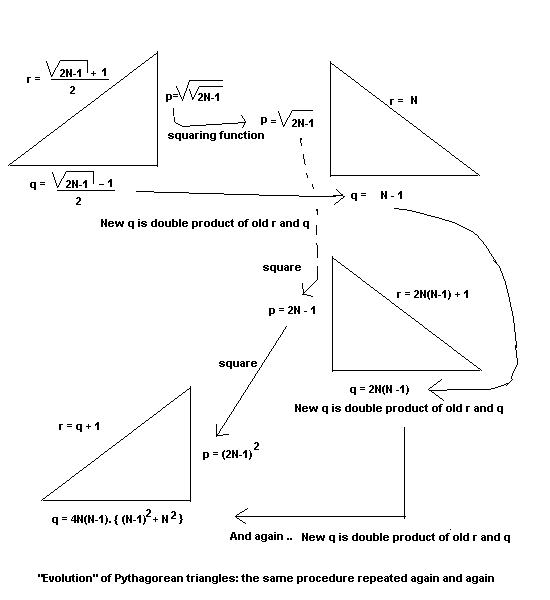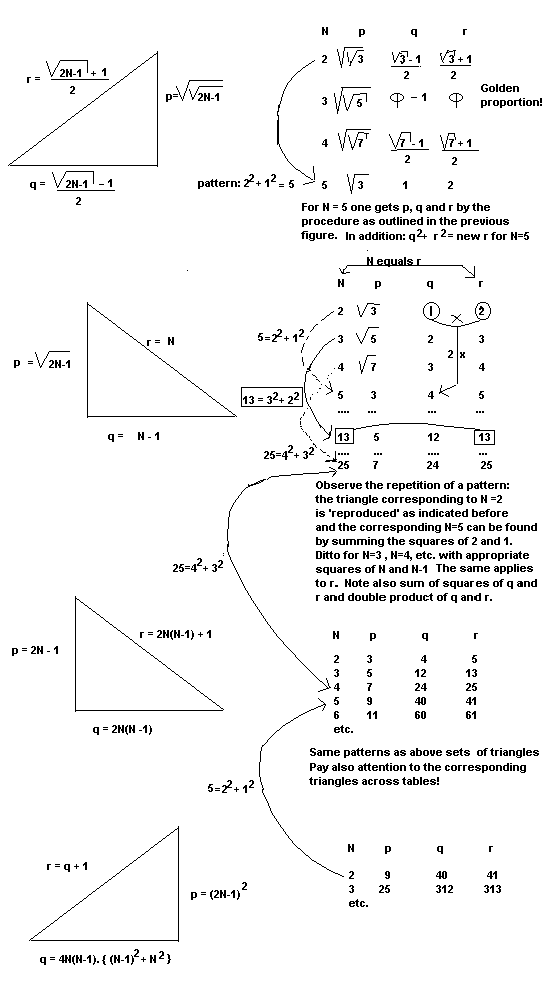Sacred Geometry Continued
authored by Martin Euser
Abstract:
Since I wrote my previous article on Sacred Geometry I did a little
research on the factor V(2N - 1) , square root of (2N -1), and found some
interesting relations between musical proportions and Pythagorean triangles.
Furthermore, I looked into the matter of the 'root-factor'- scheme a bit
further and found that the simple scheme N +/- V(N) is also interesting as a
generative set of pairs of numbers. This set looks like a prototype for the
generative set of pairs of numbers I discussed in my previous article. I will
present these findings summarily and leave it to the reader to elaborate upon
them.
The thing that got me started this time was a reference to Adrastus by Theon of Smyrna (in his book ~Mathematics useful for understanding Plato~ , publ. Wizards, San Diego). Adrastus is said to have said that out of all the different mathematical means the geometrical mean is the most important. Why this is so, is not made clear.
However it may be, I focussed on the factor V(2N-1) and thought it would be
interesting to consider this factor as a geometrical mean. Hence I sought two
terms that would yield this factor. Proceed as follows:
a : V(2N-1) = V(2N-1): b
hence: a.b = 2N - 1
I dissolved 2N-1 into two component factors: V(2N) + 1 and V(2N) -1 which can be taken to be a respectively b.
Some interesting features arise from these factors: a - b = 2 for all N and
V(2N) yields integral values for N = 2 c^2 , namely: 2c
(the symbol '^' stands for exponent, thus c^2 means: c squared)
When you elaborate these values for 2c you will find 2,4,6,8,10, etc. which
is a series that shows musical proportions (4:2 is octave, 6:4 is quint, etc.)
The number two is prevalent here. The terms a and b form interesting series
when N=2c^2, namely:
for a: 3,5,7,9, ..
for c: 1,3,5,7,..
which are of the form 2N+1 or 2N -1 (N >= 1)
One hypothesis could be that these values are the input in the term V(2N-1)
in the root-scheme formula. This would link Pythagorean triangles with this
formula (see below why this could be so).
Since proportions are the thing we're after in Sacred Geometry, I had a look at the proportions of V(p/q) where p = 2d^2 and q = 2e^2.
This formula gives rise to musical proportions:
for d = 2 and e = 1 it yields: 2/1 = 2 , the octave
for d = 3 and e = 2 it yields: 3/2 , the third or quint
for d = 4 and e = 3 it yields: 4/3, the fourth
etc.
The formula 2N^2 is thus seen to be connected with musical proportions.
Now, for some intuitive reason, I started to combine the variables d and e
in the following fashion:
sum of squares of d and e: d^2 + e^2 = r
subtract squares of d and e: d^2 - e^2 = p
double product of d and e : 2.d.e = q
for d=2 and e=1 this procedure renders: r = d^2 + e^2 = 5, p= d^2 - e^2 =3, q = 2.d.e=4 which reminded me of the famous Pythagorean triangle with sides 3, 4 and 5
This triangle is common in the physical shapes/forms of many fishes, as
Doczi shows in his book on the power of limits.
for d=3 and e=2 we get: 2.d.e = 12 , d^2 + e^2 = 13, d^2 - e^2 =5 and, yes,
this is another famous Pythagorean triangle with sides 5, 12, 13.
And so on for higher values for d and e.
So, a correlation is established between Pythagorean triangles and musical
proportions, as I have proven here mathematically. These triangles seem to be
connected to the root-number scheme too. I would not be surprised when they
would play a vital role in the structure-function-order of nature (e.g. in
atomic shell structure). After all Pythagoras was a very wise man, who taught
the mysteries in his Mystery-school and it is very likely that he knew a lot
of the workings of nature, being a (high degree) initiate himself.
Very simple properties for the Pythagorean triangles can be derived from what I have deduced already (see also figure):
r - q = d^2 + e^2 - 2.d.e = (d - e)^2 = 1 because e is taken to be d + 1
r - p = d^2 + e^2 - ( e^2 -d^2) = 2.d^2 which is the famous formula for
periodicity of electronic shell-structure
Interesting enough, r + p = 2.e^2, which refers to the same formula, but to
the next shell-number (e = d + 1).
This means that the following relations between p, q, r and d, e hold:
p = d + e = 2.e - 1 ; q = 2.d.e = 2.(e^2 -e) ; r = q + 1 = 2.d.e + 1 =
2.(e^2 - e) + 1
Abstract Pythagorean
triangle
Thus, the Pythagorean triangles can be characterized by one variable, e,
which starts with value e = 2 to render the 3,4,5 triangle and so on,
proceeding in incremental fashion e=3, e=4, etc.
Replace e by N , and we get p = 2.N -1 , the term appearing in the root
V(2N-1) .
Now, q = 2N(N-1) which equals the double of the geometric mean of the pair
N^2 + N.V(2N-1) and N^2 - N.V(2N-1)
(see my previous article for a discussion of this pair)
This is an interesting result, the ramifications of which are not yet
clear.
There may be a relation to a very simple generative set of number-pairs:
N + V(N) and N - V(N)
These pairs have the following means:
A= N ; G = V(N*(N-1)); H = N -1
which means are connected to the previously mentioned pairs:
N^2 +/- N.V(2N-1) because in that case A = N^2 ; H = (N-1)^2 and G= N(N-1)
which are simply the squares of the values of the means of the pairs N
+/- V(N)
One hypothesis is that A = N and H = N-1 feature as the terms d and e in the formulas above which connects them to p, q and r in the Pythagorean triangles.
Note that A + H = 2N-1. Furthermore, A/H gives a musical proportion , at least for N= 2,3,4 and N=9 in the Pythagorean musical scheme.
After considering the terms A=N and H=N-1 I noted that the difference between them is one unit, exactly as is the case with the variables r and q in the Pythagorean triangle. So, I figured that it would be interesting to identify A and H as the sides of this triangle and calculated the side p to be equal to V(2N-1) ! See figure

So, this is another way of viewing the Pythagorean triangles, and it may be interesting to connect the former description with this one. Mathematically, this points to some transformation of variables, mapping one description onto the other.
Indeed, I had a look at these two ways of describing Pythagorean triangles and discovered some new facets:
- embeddedness of triangles into a larger set (hierarchies,
classes/subclasses, sets and subsets or whatever is an appropriate designation
for this feature)
- a kind of repetition of these sets of triangles (fractality?)
- appearance of the famous phi proportion as sides of a Pythagorean
prototypical triangle
- connections between the small side of a triangle and a corresponding one in
the next set of triangles, as well as within the same set
In order to present my findings in a visual way (and not making this article too boring :)), I'll include a couple of images that show the features meantioned above:

Comment: a simple squaring function will transform p into a new value for the short rectangular side of a Pythagorean triangle. The transformation of q is also simple: form the double product of q and r and this will be the new value for q. The interesting feature is that you can repeat this procedure over and over again (in two directions)- see figure:

To make this abstract picture a bit more understandable we must fill in some values for N and have a look at the following tables:

In the tables I've indicated the connection between triangles within and across tables by the transformation N -> N^2 + (N-1)^2 This transformation is correlated with the other transformations p -> p^2 , q -> 2.q.r
Note also that the famous Phi proportion makes its appearance in one of the tables I've shown you in the above figure. This may be indicative of the richness of the system I'm trying to research. This system (the various representations of Pythagorean triangles, the transformations, correlations, etc.) reminds me a bit of the theosophical teachings about the development, evolution or emanation of the Elements (earth, water, air, fire, aether, etc.) out of one another in serial progression.
It exhibits a clear structure of classes with subclasses - hierarchical, so
to speak, possibly being groups and subgroups in a mathematical sense -
another feature to research. It is possible to generate more of these
triangles as indicated in the figures above, showing a kind of fractal nature
of the entire system, perhaps.
One thing is certain: there remains a lot to discover in the realm of Sacred
Geometry!